
Buta no Kakuni (Japanese Simmered Pork Belly)
Enjoy pork belly seasoned with a rich sauce, offering a melt-in-your-mouth texture! Buta no Kakuni is one of Japan's most iconic simmered pork dishes. The sweet and savory sauce penetrates deep into the meat, creating a flavor that is sure to captivate you.
Print Recipe
Pin Recipe
Servings: 3
Ingredients
- 1 ⅓ lb pork belly
- 0.4 oz ginger
- 1 oz green part of Japanese leek (naganegi) (can be substituted with regular leek)
- 2 inches white part of Japanese leek (naganegi) (optional)
- 3 boiled eggs (optional)
For the seasoning:
- 2 cups water (for step 7)
- ⅖ cup sake
- 1.8 oz sugar
- ⅓ cup soy sauce
Instructions
- Separate the green and white parts of the Japanese leek (using about 2 inches / 5 cm of the white part). Slice the ginger without peeling the skin. If the pork belly you are using is too large to fit comfortably in your pan or pot, cut it into large chunks.
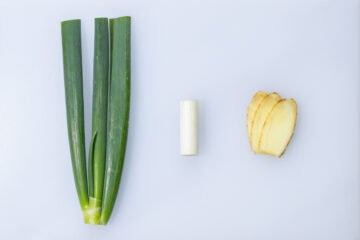
- Heat a pan over medium heat. Once the pan is hot, place the pork fat-side down and sear it for 5 minutes until it turns golden brown. Sear the remaining three sides for 1 minute each to brown them. Be sure to wipe off any rendered fat with paper towels while cooking.

- Transfer the pork to a large pot and add the green parts of the Japanese leek, sliced ginger, and enough water to fully submerge the pork. Then, bring it to a boil.
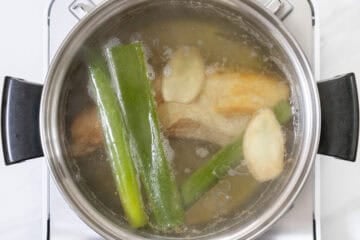
- Once the water comes to a boil, reduce the heat to very low, keeping it just at a gentle simmer. Cover the pork with a paper towel placed directly on top, and let it simmer for about 3 hours. If the water level decreases enough to expose the pork, be sure to add boiling water to keep it submerged as needed.
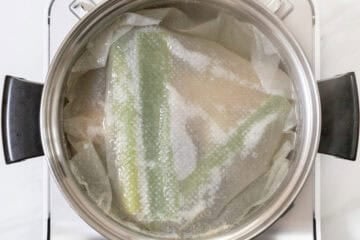
- Remove the pork from the pot and rinse it lightly under running water. Soak it in a bowl of cold water for about 5 minutes, changing the water as needed to cool it completely.As for the cooking liquid in the pot, discard it because it won’t be used in this recipe. If you want to reuse it, wait for the fat in the liquid to solidify, remove it, and then use the remaining liquid as broth for soup. You will need a large pot again in later steps, so if you plan to reuse this one, make sure to wash it now.
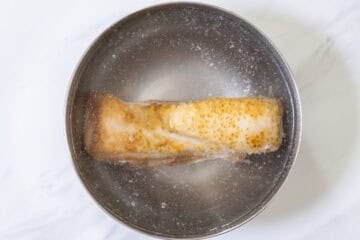
- Cut the pork into pieces slightly larger than bite-sized, about 1-1.6 inches (2.5-4 cm) wide.
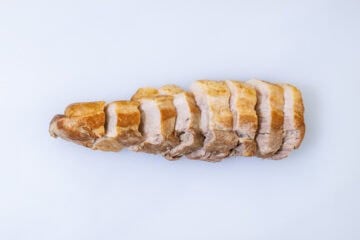
- Add water (as specified in the recipe), sake, and pork to a large pot, and bring it to a boil. Once boiling, skim off any scum from the surface. Reduce the heat to very low, just enough to keep it barely simmering, and add sugar. Once the sugar has dissolved, place a paper towel directly over the pork and let the pot simmer for about 10 minutes.
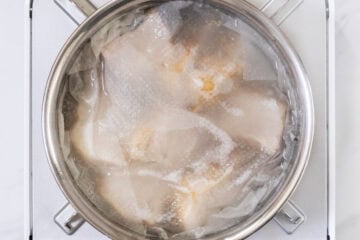
- Pour soy sauce over the paper towel, then bring the pot back to a boil over medium heat. Once it starts boiling again, reduce the heat to very low and let it simmer for 1 hour. After simmering, remove the pot from the heat and let it rest overnight (about 8 hours or more) to allow the flavors to soak into the pork. Make sure to transfer the pot to the refrigerator, covered with a lid, once it has cooled to room temperature.
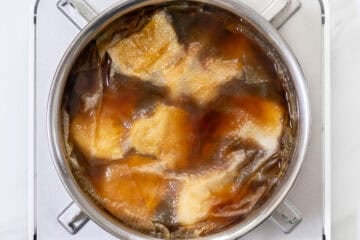
- (When adding boiled eggs) Peel boiled eggs and place them under the paper towel in the pot, allowing them to soak up the flavors along with the pork. If you are using soft-boiled eggs, be sure to add them only after the pot has cooled to room temperature.For instructions on how to make soft-boiled eggs, refer to the "Optional Additions" section above.

- Remove as much solidified fat as possible from the surface of the liquid in the pot. Bring the liquid to a brief boil, then turn off the heat. If any part of the pork is sticking out of the liquid, flip it over to ensure even heating. It is now ready to serve.
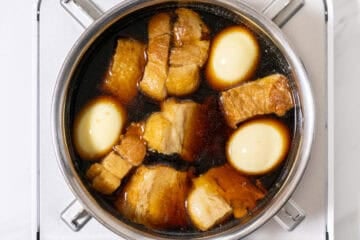
- (When adding shredded Japanese leeks) Remove the inner pale green parts of Japanese leek, then thinly slice the white sections into long, narrow strips. Soak the sliced leeks in water to mellow their sharp flavor, then drain and pat them dry. Once your buta no kakuni is ready, garnish it with the shredded leeks.
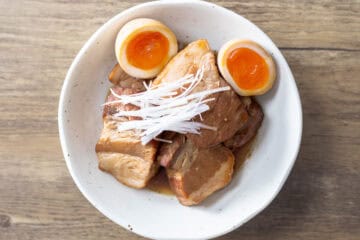
Notes
- You can store it in the refrigerator for up to 4 days.
- You can simply discard the leftover cooking liquid after making this dish. However, if you add boiled eggs and let them soak up the flavors, you will have flavorful seasoned eggs to enjoy again.
- The listed nutritional values are estimates based on the assumption that all of the seasoned cooking liquid is consumed.
Nutrition
Calories: 960.8kcal Carbohydrates: 20.08g Protein: 22.17g Fat: 84.91g Saturated Fat: 30.63g Polyunsaturated Fat: 9.2g Monounsaturated Fat: 39.09g Cholesterol: 294.5mg Sodium: 1580.04mg Potassium: 408.01mg Fiber: 0.28g Sugar: 17.79g Vitamin A: 341.68IU Vitamin C: 0.93mg Calcium: 45.96mg Iron: 2.11mg
Enjoyed this recipe?I’d really appreciate it if you shared it with your friends.